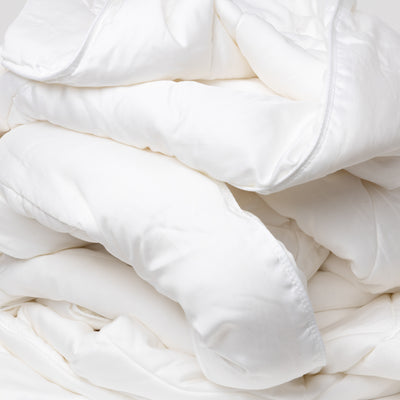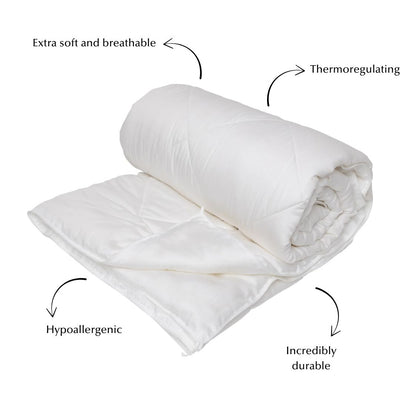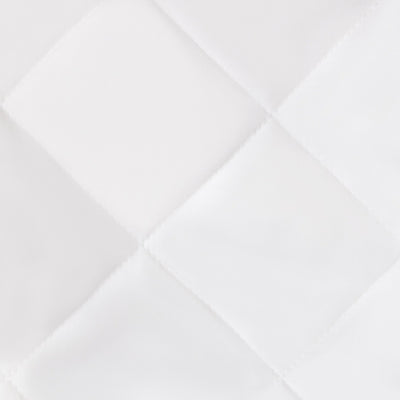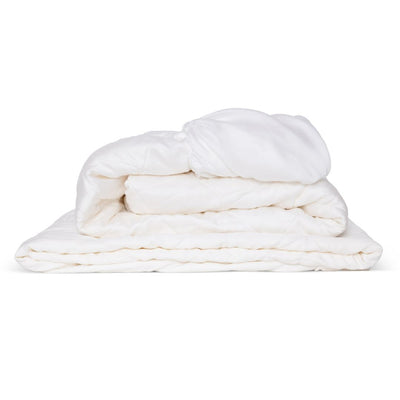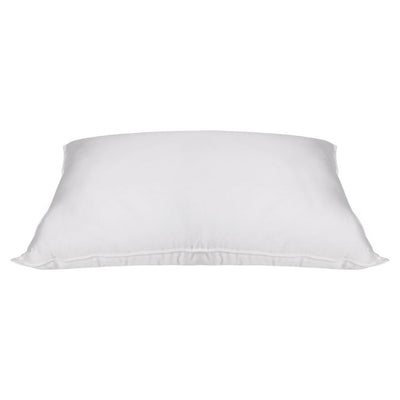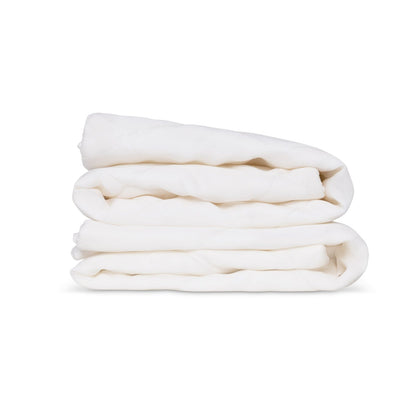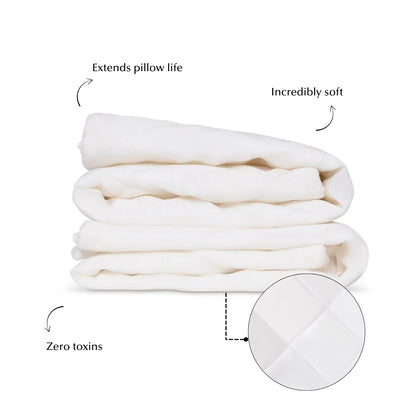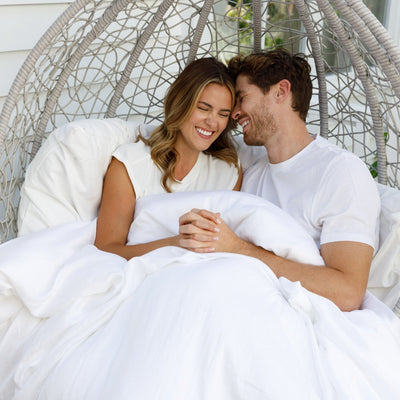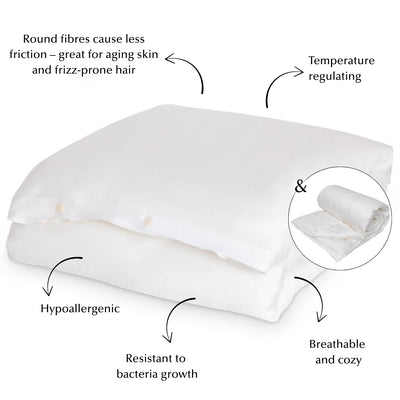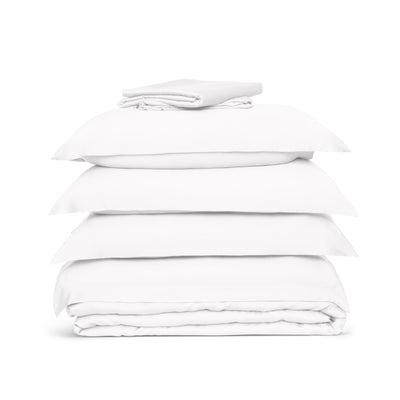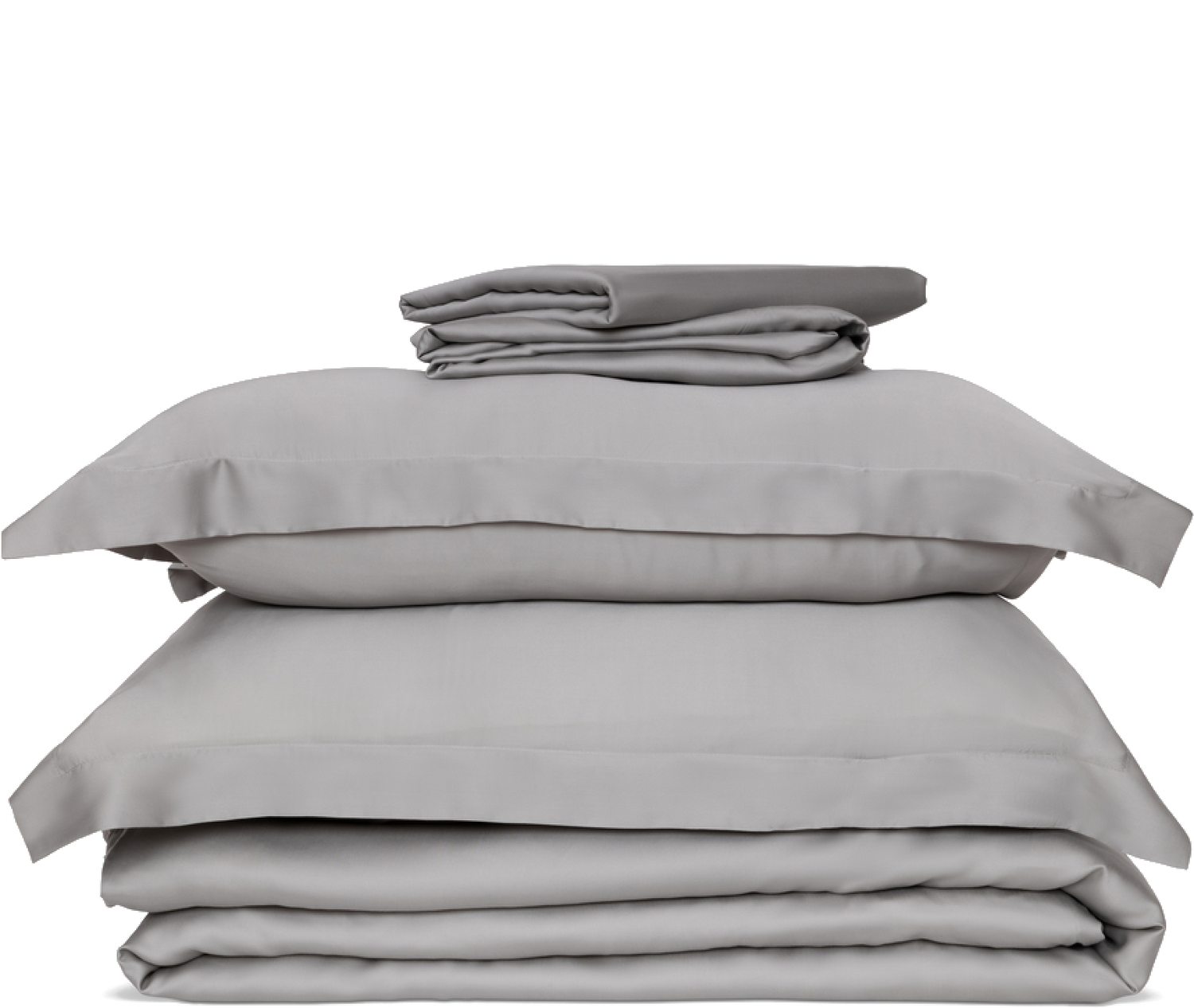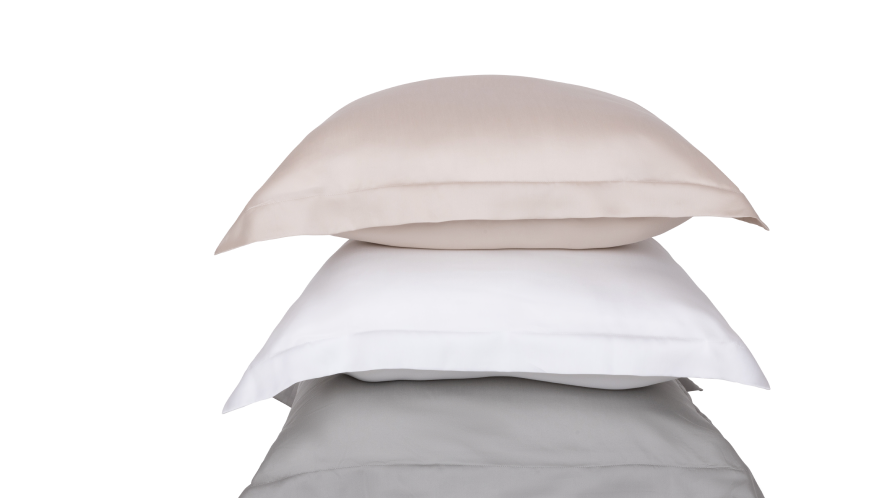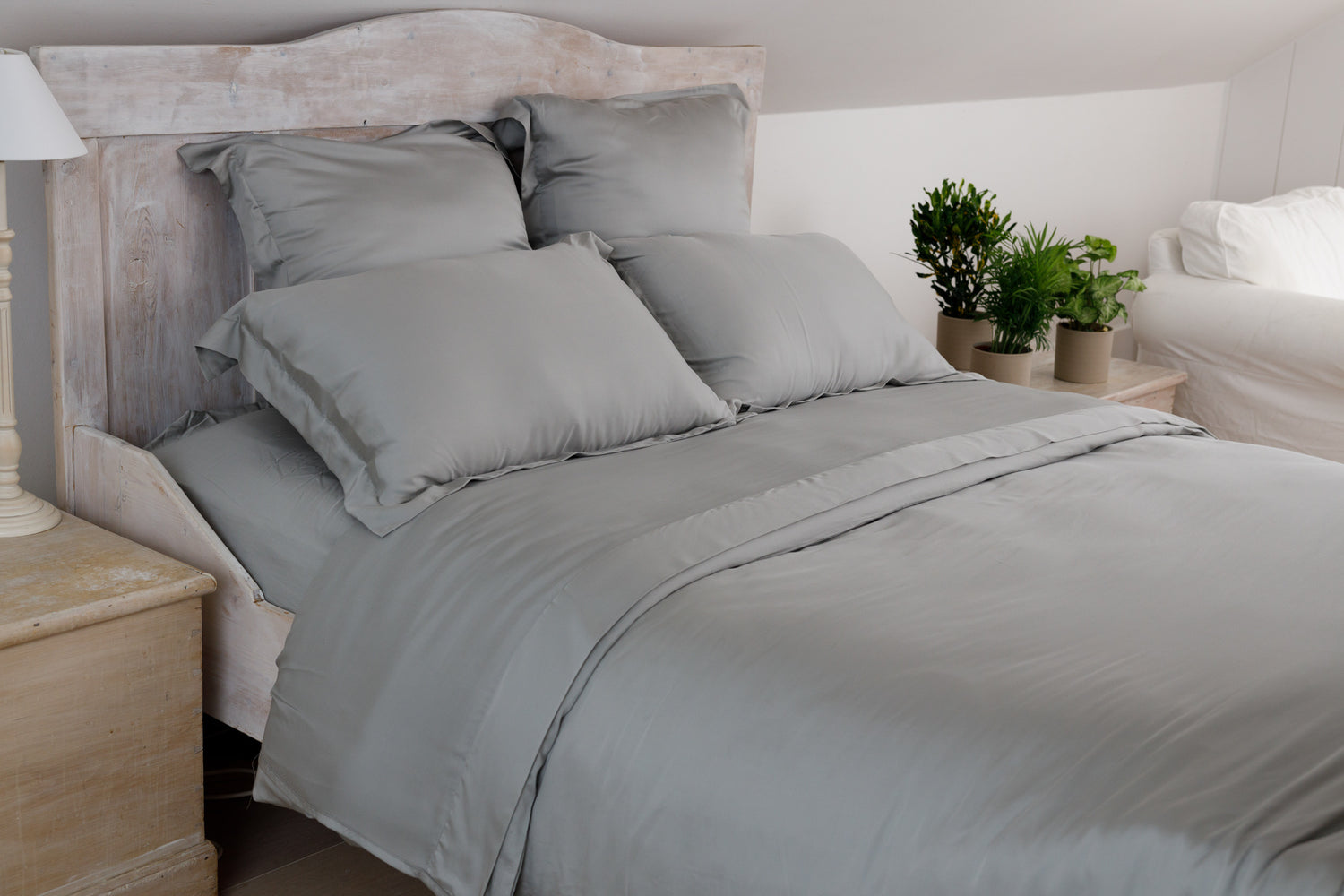An ancient fabric first produced in China at the tail end of the Stone Age, silk has come a long way since. Coming from silk worms, silk used to be a sought-after source of income for Chinese farmers, and as weaving techniques improved, the reputation of Chinese silk spread across the empires of the ancient world.
China’s most important export for most of its history, the great trading network the Silk Road connected East Asia to Europe, India and Africa.
Its soft, luxurious feel is misleading. Silk is one of the strongest natural fibres and its ability to regulate temperature make it popular in both hot and temperate climates.
Silk bedding changes the way you sleep. Let’s explore all the benefits of silk bedding.
Silk Is A Natural Fabric
When you sleep, you’re breathing in the very molecules in the surrounding air. Synthetic materials constantly are off-gassing the chemicals which are used in the manufacturing process. Some bedding material like cotton is commonly treated to make it fire and wrinkle resistant.
Silk, being a natural fibre, reduces your exposure to dangerous chemicals and is naturally wrinkle-free and fire-resistant.
Temperature Control
Because of the breathable nature of silk fibres, body heat and sweat gets wicked away and is vented naturally instead of getting trapped under sheets.
Silk wicks away the moisture at approximately twice the rate of cotton, reducing the humidity further and making those hot nights well, not so hot anymore!
Mites, mould and mildew love humidity and warmth. Lower the humidity of your sleeping environment and say goodbye to that nasty stuff.
Think about a silk duvet cover, which will maintain your body’s temperature and let you sleep during the hottest times of the year in unrivalled comfort.

Get 10% off Ethical Bedding's breathable Summer Duvet with code SILKY10
Hypoallergenic
Allergies a problem for you? Sensitive to pollen, dust and mites? The most common cause of allergies in the bedroom are dust mites.
Those tiny microscopic creatures cause big trouble for people with a delicate respiratory system. They live in our bedding, feeding on our skin that we shed, and studies have shown that up to 2,500 mites can be found on a single gram of dust!
The enzymes released from dust mite droppings are the culprit. When you inhale the droppings of the mites, you trigger the allergic reaction.
Silk is naturally hypoallergenic! With the added bonus of not having to inhale the faeces of the little troublemakers.
Great for Skin
The tightly-woven fibres of silk help keep the moisture closer to the skin, slowing down the signs of aging and appearance of wrinkles.
There are studies that show that sleeping on silk can impair and prevent the formation of fine lines and wrinkles. The natural fibre speeds up the metabolism of skin cells, ensuring they replenish at a faster rate, leading to healthier skin. This probably coined the phrase “silky smooth skin”!
Great for Hair

The soft textures of silk allows the hair to slide over the fabric instead of knotting and breaking. No more pesky tangles in the morning! Silk also doesn’t hold static electricity and won’t cause the frizzy, wild look in the mornings. Hence hair that is “smooth as silk”!
Silk also preserves the hair style while you sleep. Wrapping a silk scarf around your head will slow the increase of oils in your hair, and whatever style you went to bed with will be held for a couple more days. More on this later!
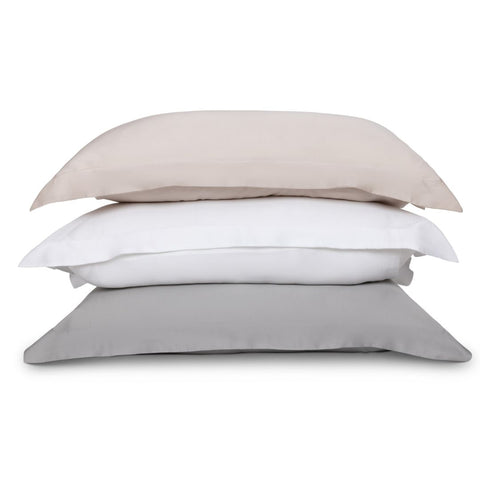
Shop Ethical Bedding's Eucalyptus Silk Pillowcases
Comfort
Of course, the phrase “soft as silk” comes from somewhere! It’s incredibly soft texture and feel allows your skin and hair to slide across your bedding with very little friction. This bodes well for sensitive or irritated skin from sunburns, eczema, or other conditions.
Made your mind up? Making the switch to silk? Read on to answer all the questions you might have and by the end of the day, you’ll be an expert on this luxe, beautiful fabric.
Where Can I Buy Silk Bed Sheets?
With online shopping these days more popular than ever, a good start would be checking to see if your favourite online retailer has some. Amazon has plenty of options, as do Nordstrom and eBay.
If you’re like us and like to touch and see your purchase before committing, try heading to the large department and furniture stores which usually carry them.
Be warned. Silk bed sheet sets are more expensive than standard sets, but hey, you spend one third of your life in bed!
Can Bed Bugs Live On Silk Sheets?
Absolutely not!
As mentioned above, Silk is a hypoallergenic fabric that repels mites, bed bugs and other nasty creepy crawlies that find their way into your bed at night.
IS SILK BEDDING VEGAN FRIENDLY?
Silk is not considered a vegan product. After making the silk cocoon, larvae are boiled until dead to prevent them breaking through the cocoon once they are ready to become a fully developed moth.
Some Bombyx Mori are spared for breeding, which produces the next generation of larvae. They have been bred into domestication and no longer have a functional mouthpiece or wings so cannot eat or fly for their 2-3-day lifespan.
How To Silk Wrap Hair For Bed?
As mentioned before, wrapping your hair (and head!) with a silk scarf before bed protects your hair and maintains the style that your hair went to bed with you in. Whether it is a silky smooth and straight look or curls, a simple routine before bed with a 100% pure silk head scarf will keep your ‘do for days to come.
The rough texture of cotton causes friction that weakens and tangles your hair while you toss in the night, resulting in breakage, that dreaded morning frizz and dryness. The smoothness of silk causes hair follicles and strands to glide protected throughout the night and maintain a healthy balance of natural oils.
The natural oils from your scalp is held in by the silk, preventing greasy hair as the fabric disperses the oils from the follicle to the tips instead of concentrating oils purely on your scalp.
This allows the oils from your scalp to act as a naturally nourishing, conditioning treatment throughout the night, and fewer greasy hair days means less washing days.
Intrigued? Wanna know how to wrap your hair? Lots of videos are online, check some out!
Are Silk Bed Sheets Comfortable?
Yes! As mentioned above, silk being a temperature-regulating, breathable, and hypoallergenic fabric is well-worth the extra dollar spent.
The weight and quality of silk is measured by something called the momme. Momme [mom-ee] is a Japanese word used as a unit of weight measurement for real silk.
A higher momme value indicates a higher quality fabric. Silk should have a minimum fabric weight of 15 momme.
Do Silk Pillowcases Cause Bed Head?
If investing in a full set of pricey sheets are not what you are looking for now, you can think about silk pillowcases.
As with the silk scarf hair wraps, silk pillowcases don’t cause as any friction as regular cotton ones, and your hair glides smoothly on them as you toss and turn at night. Friction disrupts the cuticle layer of hair which in turn, causes bed head and frizzy hair.
As mentioned above, silk also distributes the natural oils from your scalp and keeps your hair moisturized and happy throughout your sleep.
How To Keep Silk Sheets On The Bed?

They don’t call silk “silky smooth” for nothing. Silk slides, and it slides a lot! Keeping your silk bed sheets or your duvet cover on the bed throughout the night might prove a bit of a challenge to those that are new to this fabulous fabric.
When you first start to use silk sheets, you’re probably going to struggle with sheets sliding around everywhere, and whatever you do, they never seem to stay on. You’d probably be tempted to use a stapler!
Fear not, here are some tips to help keep sheets on the bed.
Use Sheet Suspenders
These nifty little gadgets are easily purchased online and don’t cost very much. Suspenders clip onto the corners of the fitted sheet, slipping around the edges of the mattress. This creates more constant pressure that doesn’t loosen no matter how much you toss and turn during the night.
Some cross-section suspenders even come with a strap that goes down the middle of the mattress underside.

Use Non-Slip Rugs
You know the non-slip rug undersides that keep us safe in our bathrooms and kitchens and that are designed to grip on various surfaces. Find sections of non-slip rug undersides and place each one underneath the sheet on each corner of the mattress.
This makes it harder for the sheet to slip on the corner of the mattress underside.
Safety Pin It!
Good old’ fashioned safety pins work just as well. When all else fails, add a barrage of pins to each corner of the sheet and make sure to pin with the pressure of the tug, rather than against it, to keep the pins from bending and weakening.
Try using heavy duty, yet thin pins to prevent damage to the sheets yet retain the holding strength. They are readily available online and cost very little.
Check Your Mattress
A lot of slipping sheets are due to incorrectly sized bedding. You’ll be surprised to know how many people size their bedding wrongly, and don’t pay enough attention to the actual dimensions.
These days because of irregularities in measurements across countries, “Queen” isn’t a standard size anymore, as neither is “King”. Get the actual and exact dimensions of your mattress, and buy the sheets to fit that.
Some mattresses like thick hybrid and coil mattresses also have a tendency to be thicker. “Deep” sheets, available widely, can handle up to 15” thick mattresses.
Standard sheets usually only fit mattresses that are 7-14” thick. If you have an extra thick mattress, you’ll need extra deep sheets that can take up to 16-22”.

How Much Are Silk Bed Sheets?

As mentioned before, the quality and weave of silk is measured by the momme. During the manufacturing process of silk, the factory will adjust the density and yarn count of the silk thread to control the weight - or momme - of the finished fabric.
A sheet made at 30 momme will have silk fibres that are woven more closely together than a 19-momme sheet. Higher momme silk is also made with thicker yarn. This manner of measurement is similar to the “thread count” of other materials.
Of course, as with anything, you pay for quality. The higher the momme count, the pricier your sheets will be. Also look for 100% pure silk and not inferior blends of silk and other fabrics, or satin.
A quick look at sets with two pillow cases, a duvet cover and a fitted sheet yielded some sets going for under £200 and between 19-22 momme, and some luxurious sets for over £1,000!
Is Silk Bedding Cooler?
Yes absolutely! As mentioned above, Silk is a natural, breathable material. Not only does the breathability of the material keep your sweat vented, its ability to wick moisture away keeps the humidity down.
Is Silk Bedding Worth It?
On this note, it all boils down to personal preference, and how much you value the properties of silk. For the allergic, it might be well worth the price to avoid sneezing and wheezing through the night, and for those that want unparalleled comfort, this might be the answer.
If you’re like some people and sleep like a log through the night on coarse fabric and don’t give a hoot about comfort, the comparatively high price tag on a silk bed sheet set might deter your purchase.
It’s all up to you, but remember, we spend ONE THIRD of our lives sleeping! That’s a lot of time to spend for a sub-quality experience.
Are Silk Bed Sheets Haram?
Yes, it is haram for a man to use brocade and silk in clothing, or for sitting or reclining on, or covering himself with it (like a blanket), or as a curtain or screen, or any other way of using it.
Do Silk Bed Sheets Crease?
Silk sheets very often stop wrinkling after the first few washes, and don’t require any ironing. However, if you do have stubborn wrinkles in your silk sheets, you can iron them carefully.
First, use the iron on the minimum heat setting to prevent damage to the sheets, and slowly increase the heat if necessary.
Iron on the backside of the sheet, the side with the matte finish. This again, minimizes the chance of damage to the silk.
Iron the sheets fast, and keep the iron moving constantly, never letting the iron linger too long in one spot.
How Often Should You Clean Silk Bedding?
Silk sheets should be cleaned approximately every two weeks. The sheets are breathable and will be repelling moisture, but still can absorb microorganisms.
Hand washing them with silk-friendly detergent would be preferable, but if you really want to machine wash your sheets, run them through a cool delicate cycle then air dry them out of the sun. Silk sheets dry out in no time, so check the dryness of the sheets every 15 minutes or so.
If your sheets have a stubborn stain from food, beverages, or blood, pour distilled white vinegar directly over the stain and let it sit for 15 minutes, then rinse the vinegar off the sheet under plain cool water.
What Is The Difference Between Satin and Silk?
Often used in tangent, satin sometimes is confused with silk. Fabric that looks and feels like silk but is not silk, is known collectively as satin.
Satin is the way a fabric is woven, and can be made up of many fabrics such as cotton, polyester, rayon and acetate. The ability to create satin from synthetic fibres means satin is more flexible and supple and can be any blend of synthetic materials.
Silk is the fabric itself, a 100% natural protein gained from the cocoons of silkworms.
Silk has a multi-coloured sheen and becomes warm when you rub the fabric between your fingers. If satin shines too much, it might be polyester, a polyester blend or the woven silk is soaked in layers of silicone finishes.
Even more convincing is the burn test. If you take a silk fibre and hold it to a flame, the fibre will burn slowly as with all natural fibres, whilst synthetic fibres will melt and continue to melt a little after you remove the flame.
Burnt silk has a tendency to smell of charred meat or burnt hair, while burnt synthetics smell of acrid chemicals or vinegar.
Residue is a black, hollow, irregular bead that can be easily grinded into a greyish ash powder.
Ethical Bedding

We here at Ethical Bedding had a dream when we set up the company. We wanted to help everyone sleep better, whilst protecting the planet.
Ethical bedding is the closest thing you can get to silk in terms of the feel of our fabrics, especially our sateen weave. Our fabrics are also, like silk, ‘zero friction’ which means they are great for both skin and hair, naturally hypoallergenic, resistant to mites and mould, far more breathable, affordable and durable than silk!!
We realized that producing cotton consumes a huge amount of water, damages natural habitats and robs animals of their home. All this to create the sheets on which we sleep in. This wasn’t right.
We set off to find the softest, most environmentally-friendly organic fabric and found 100% Tencel weave, harvested sustainably from eucalyptus trees.
Our bedding is produced using a closed loop manufacturing process, meaning all our products are eco-friendly and safe from the environment. Our Tencel fabric is sourced from Forest Stewardship Council forests, where the trees are harvested and not uprooted, allowing them to grow back quickly.
The process of turning eucalyptus wood into fibre uses 95% less water than cotton, less land and zero herbicides and pesticides.
The fibre is then spun into a yarn that is ready to be weaved by our 110-year-old family-owned manufacturing partners in Portugal whose expertise in global textiles span 3 generations.
Our products have won the “European Award for the Environment” by the EU, as well been awarded “European Community Eco-label Flower” for products with low environmental impact.
Eucalyptus fibres are environmentally more sustainable than organic cotton, requiring less land and water throughout the manufacturing process. It is also naturally hypoallergenic with no added toxic chemicals.
A typical cotton sheet contains some 2,000 chemicals, whilst our sheets contain just one.
We are so confident of our product that we offer a 100-day trial to make sure you’re happy. Any returns (if any at all!) will never be sold. We have partnered with St. Mungo's homelessness charity in London, which will be the recipient of most of our returns. The returned products are mostly used in shelters or hostels.

Check out our Bed Sheet Set (Ultimate Bundle)
If the item is in a bad condition, we dispose of them via a textile recycling facility. Even though all our products are biodegradable and designed to decompose, we would prefer keeping them out of the landfills. Give us a try, check out our range here!

